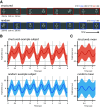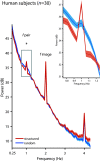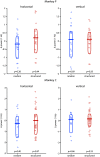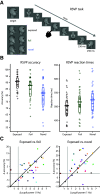Pupil Diameter Tracks Statistical Structure in the Environment to Increase Visual Sensitivity
- PMID: 32371603
- PMCID: PMC7275858
- DOI: 10.1523/JNEUROSCI.0216-20.2020
Pupil Diameter Tracks Statistical Structure in the Environment to Increase Visual Sensitivity
Abstract
Pupil diameter determines how much light hits the retina and, thus, how much information is available for visual processing. This is regulated by a brainstem reflex pathway. Here, we investigate whether this pathway is under the control of internal models about the environment. This would allow adjusting pupil dynamics to environmental statistics to augment information transmission. We present image sequences containing internal temporal structure to humans of either sex and male macaque monkeys. We then measure whether the pupil tracks this temporal structure not only at the rate of luminance variations, but also at the rate of statistics not available from luminance information alone. We find entrainment to environmental statistics in both species. This entrainment directly affects visual processing by increasing sensitivity at the environmentally relevant temporal frequency. Thus, pupil dynamics are matched to the temporal structure of the environment to optimize perception, in line with an active sensing account.SIGNIFICANCE STATEMENT When light hits the retina, the pupil reflexively constricts. This determines how much light and thus how much information is available for visual processing. We show that the rate at which the pupil constricts and dilates is matched to the temporal structure of our visual environment, although this information is not directly contained in the light variations that usually trigger reflexive pupil constrictions. Adjusting pupil diameter in accordance with environmental regularities optimizes information transmission at ecologically relevant temporal frequencies. We show that this is the case in humans and macaque monkeys, suggesting that the reflex pathways that regulate pupil diameter are under some degree of cognitive control across primate species.
Keywords: active sensing; primate; pupil; statistical learning.
Copyright © 2020 the authors.
Figures







References
-
- Benjamini Y, Yekutieli D (2001) The control of the false discovery rate in multiple testing under dependency. Ann Stat 29:1165–1188.
Publication types
MeSH terms
LinkOut - more resources
Full Text Sources
